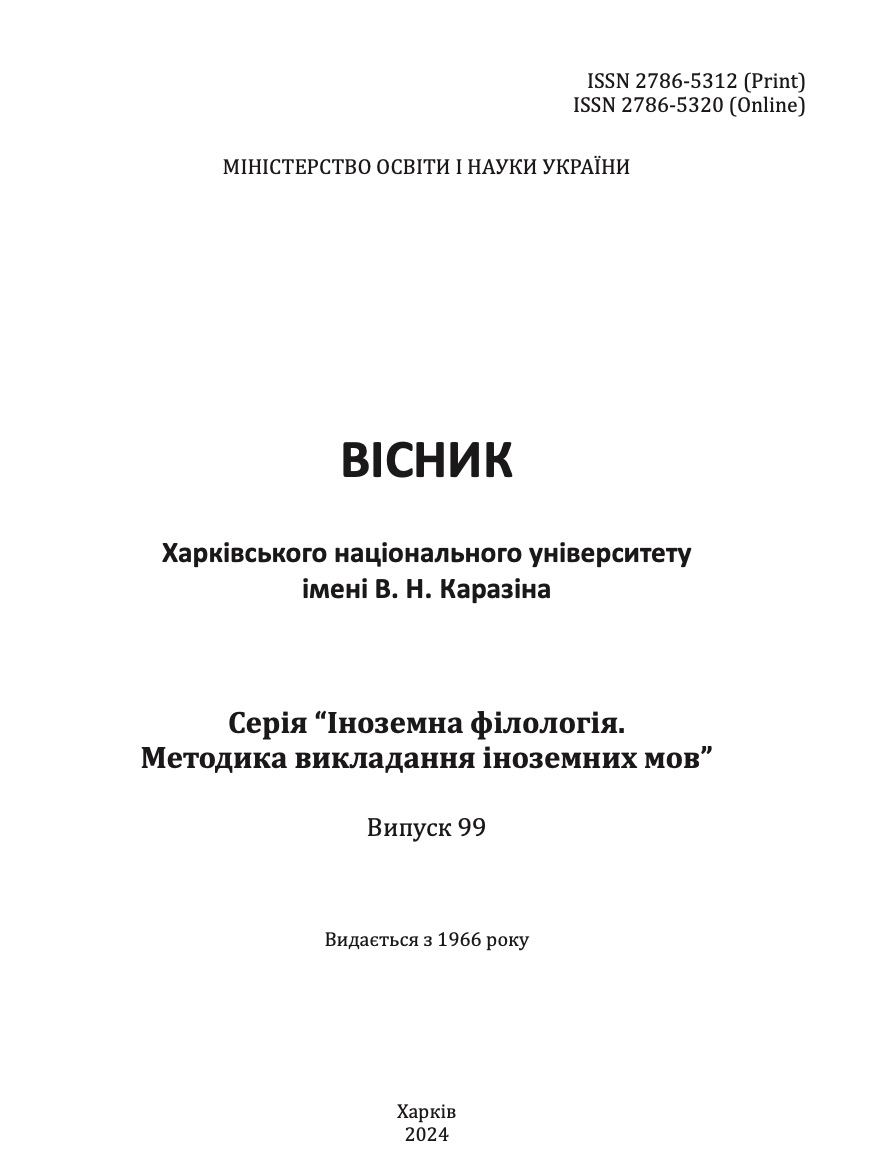The ways of forming possible worlds of literary text characters: A cognitive linguistic aspect (a study of the novel “Treasure Island” by R.L. Stevenson”)
Abstract
The article aims to expose various ways along which possible worlds of the characters’ images in the novel “Treasure Island” by R.L. Stevenson are formed. The methodological toolset leveraged in the paper combines the contemporary techniques of cognitive linguistics (namely, semantics of lingual networks) with the basic tenets of the possible worlds theory. The characteristics of the central protagonists of the novel Jim Hawkins and John Silver were analyzed with the help of basic propositional schemas. The characters exist in the novel in several possible worlds which are identified on the basis of the evaluation of the protagonists’ features, the change of the main characters’ location, and the dynamics of their axiology. As the analysis manifested, possible worlds of Jim Hawkins are formed according to the sequential model when the character matures with the unraveling of the plot, transforming from a Child into a Teenager and then into an Adult. A timid and dreamy boy gives way to a somewhat reckless and impulsive youth who finally turns into a courageous man. This maturation enables him to help his friends find the treasure and capture without anybody’s assistance the ship which they use to return home. The image of John Silver has a more complicated architecture since he features in two parallel possible worlds simultaneously as the Ringleader of pirates (nicknamed Barbecue) and Ship’s cook. He shuttles between these two epitomes during the development of the narration trying to achieve his goals. John Silver can wear a disguise of an amiable and hard-working member of the ship’s crew and then suddenly change into a cruel and greedy buccaneer who in cold blood murders people, starts a mutiny, and sticks at nothing to get his share of the treasure. When the mutiny fails, Silver feigns loyalty and obedience by betraying his cronies, but once the ship arrives in England his criminal self surfaces again.
Downloads
References
Bell, A., & Ryan, M.L. (2019). Possible Worlds Theory and Contemporary Narratology. Lincoln, Nebraska: University of Nebraska Press.
Doležel, L. (1998). Heterocosmica: Fiction and Possible Worlds. Baltimore and London: The Johns Hopkins University Press.
Graesser, А. С., Singer M., & Trabasso T. (2002). Constructing Interferences during Narrative Text Comprehension. New York:Basic Books.
Hidalgo Downing, L. (2003). Text world creation in advertising discourse. Círculo de Lingüística Aplicada a la Comunicación (CLAC), 13, 23–44.
Hilpinen, R. (1971). Deontic Logic: Introductory and systematic readings. Dordrecht: D. Reidel.
Hintikka, J., & Hintikka M. B. P. (1990). The Logic of Epistemology and the Epistemology of Logic: Selected Essays. Dordrecht, Boston, London: Kluwer Academic Publishers.
Korotkova, L. (2001). Semantyko-kohnityvnyi ta funktsionalnyi aspekty tekstovykh anomalii u suchasnii anhlomovnii khudozhnii prozi [Semantic, cognitive, and functional aspects of text anomalies in modern English-language prose]. Unpublished candidate dissertation thesis, Kyiv National Linguistic University, Kyiv, Ukraine (in Ukrainian).
Kotovska, O. (2015). Typolohiia mozhlyvykh svitiv u kohnityvnii linhvistytsi [Typology of possible worlds in cognitive linguistics]. Naukovyi chasopys NPU imeni M. P. Drahomanova, 13, 127–135 (in Ukrainian).
Kripke, S. (1980). Naming and Necessity. Cambridge, MA: Harvard University Press.
Kripke, S. (2021). Identity and Necessity / Indentität und Notwendigkeit (Englisch/Deutsch). In: Reclam Great Papers (German edition). Ditzingen: Reclam Verlag.
Leibniz, G. (1710). Theodicy. Essays on the Goodness of God, the Freedom of Man and the Origin of Evil. Retrieved from:https://www.gutenberg.org/files/17147/17147-h/17147-h.htm
Leibniz, G. (1714). The Monadology. Retrieved from:http://home.datacomm.ch/kerguelen/monadology/printable.html
Livyts’ka, I. A. (2020). Teoriia mnozhynnykh svitiv ta uiavnyj svit khudozhn’oho tvoru: tochky vzaiemodii [Possible worlds theory and imaginary world of fiction: points of interaction]. Zakarpats’ki filolohichni studii, 12(2), 149–152 (in Ukrainian).
Mykolaichuk, N. (2014). Teoriia mozhlyvykh svitiv u khudozhnomu prostori novely F. Kafky «Perevtilennia» [Possible worlds theory in the literary space of “Metamorphosis” by F. Kafka]. Studia methodologica, 3, 145–151 (in Ukrainian).
Obelets, Yu. (2006). Temporalna struktura mozhlyvykh svitiv khudozhnoho tekstu [Temporal structure of possible worlds of a literary text]. Unpublished candidate dissertation thesis, Odesa National University, Odesa, Ukraine (in Ukrainian).
Pavel, T. (1986). Fictional Worlds. Cambridge (Mass.) and London: Harvard University Press.
Pavkin, D. M. (2021). Possible worlds of a literary text character: a cognitive and quantitative linguistic approach. Cognition, communication, discourse, 22, 59–76.
Pavkin, D. M. (2022). Reading riddles aright: a cognitive linguistic analysis of English and Ukrainian riddles. Visny`k XNU im. V.N. Karazina. Inozemna filologiya. Metody`ka vy`kladannya inozemny`x mov, 95, 20–28.
Ronen, R. (2020). Possible Worlds. Retrieved from: https://oxfordre.com/literature/display/10.1093/acrefore/9780190201098.001.0001/acrefore-9780190201098-e-1082.
Russell, B. (2021). A History of Western Philosophy. Kindle Edition.
Saint-Gelais, R. (2005). Transfictionalty. In: D. Herman et al. (Eds.) The Routledge encyclopedia of narrative theory
(pp. 612–613). London: Routledge.
Searle, J. & Vanderveken, D. (1985). Foundations of illocutionary logic. Cambridge: Cambridge University Press.
Semino, E. (1997). Language and World Creation in Poetry and Other Texts. London: Longman.
Shakespeare, W. (1986). Yak vam ce spodobayet`sya [As you like it]. In Tvory` v shesty` tomax. Tom 4 [Works in 6 volumes. Vol. 4] (pp. 89–170). Ky`yiv: Dnipro.
Skovgaard-Olsen, N. (2023). Worlds Truth Table Task. Cognition, Vol. 238. Retrieved from: https://www.sciencedirect.com/journal/cognition/vol/238/suppl/C
Werth, P. (1999). Text Worlds: Representing Conceptual Space in Discourse. London: Longman.
Zhabotynska, S. А.(2018). Generatyvizm, kognityvizm i semantika lingval’nyx merezh [Generativism, cognitivism, and semantics of lingual networks]. In: Doctrina multiplex, veritas una: A collection of studies commemorating the jubilee of I.R. Buniyatova (pp. 99–141). Kyiv: B. Hrinchenko University Publ (in Ukrainian).
Zhabotynska, S. A. (2019). Semanty`ka lingval`ny`x merezh u navchal`nomu kombinatornomu tezaurusi [Semantics of lingual networks in an educational combinatory thesaurus]. Studia Phililogica. Filologichni studiyi, 13, 17–27 (in Ukrainian).
Zhabotynska, S. А. (2020). The active learner’s construction-combinatory thesaurues: user-driven principles of compiling (a cognitive linguistic approach). Cognition, communication, discourse, 21, 93–107.
Stevenson R. L. (1994). Treasure Island. London: Penguin Books.




